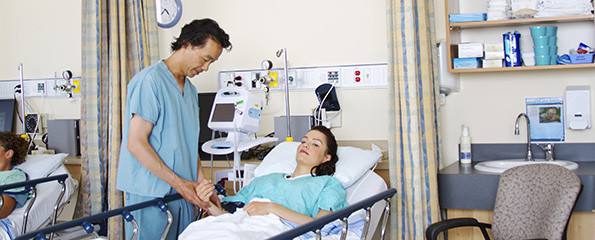Understaffed wards lead to infections and worsening health
Patients on wards understaffed by nurses are more likely to experience a range of negative outcomes, including surgical wound infection, pressure injuries, urinary tract infections and pneumonia, according to a new study by ECU nursing researchers.
Professor Di Twigg, Head of the School of Nursing and Midwifery, and colleagues Lucy Gelder and Helen Myers, mapped the journey of patients through hospital, looking at how much time they spend on understaffed wards, then examined the individual outcomes the patients experienced.
“A lot of work on staffing in the past has looked from a hospital level — you look at patient outcomes and staffing across the hospital or break it down to ward level and say that over time you have these sorts of nursing hours and these sorts of patient outcomes,” Professor Twigg said.
“What is different with this work is that we have tracked the patient’s journey through the hospital as they get moved from ward to ward and measured their exposure to understaffed shifts.
“It’s innovative in that respect and as far as we know only one other study has approached it from this perspective.”
The researchers looked at what are known as nurse-sensitive patient outcomes — problems that might arise if a nurse is unable to intervene to improve the patient’s state, behaviour or perception.
Professor Twigg said understaffing might not lead to critical or urgent issues being missed, but important, less urgent things could be given less priority, despite the potential for a negative outcome.
“If you think about it, the only reason you put patients in hospital is because they need 24/7 nursing care,” she said.
“If you have fewer nurses on shift then things that are perhaps associated with comfort can get reduced in priority or bumped on to the next shift.
“If you look at pressure injuries, for example, the nurse might know the patient needs to go on to a pressure-relieving device or have some measure taken to reduce their risk but if you are short-staffed, you may well leave implementing that until later in the shift or the next shift.
“If they had an increased risk of deep vein thrombosis, a lot of the measures are around motion and leg exercises but if you are really pushed and don’t have time to get that patient up and support them there are consequences to that.”
Over time, those delayed activities can have a significant impact on patient outcomes, she said.
Professor Twigg said the research would now be followed up to see if this method of analysing nurse staffing levels and patient outcomes had wider applicability.
“We have set this up as a pilot work as it is quite innovative and we think it is a more accurate way of looking at staffing issues in the hospitals,” she said.
“We are in the process of writing up the theory behind this and how it might be a better way of testing changes of staffing — and ultimately understanding the efficiency of the hospital.
“After all, if you have a pressure injury or a deep vein thrombosis you are going to end up staying longer and that means adding the cost of your stay.”
The paper, “The impact of understaffed shifts on nurse-sensitive outcomes”, has been published in the Journal of Advanced Nursing.
(Source: Edith Cowan University, Journal of Advanced Nursing)
Dates
Created by:

 Login
Login














